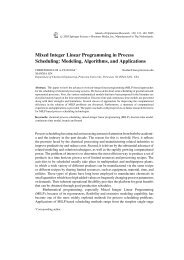Conceptual framework: What do you think is going on?
Conceptual framework: What do you think is going on?
Conceptual framework: What do you think is going on?
You also want an ePaper? Increase the reach of your titles
YUMPU automatically turns print PDFs into web optimized ePapers that Google loves.
03-Maxwell.qxd 10/1/2004 3:13 PM Page 46<br />
46 QUALITATIVE RESEARCH DESIGN<br />
theories about the phenomena <str<strong>on</strong>g>you</str<strong>on</strong>g> are studying—including sources other than<br />
“the literature”—<str<strong>on</strong>g>is</str<strong>on</strong>g> an important counterweight to the ideological hegem<strong>on</strong>y<br />
of ex<str<strong>on</strong>g>is</str<strong>on</strong>g>ting theory and research.<br />
There are thus two main ways in which qualitative researchers often fail<br />
to make good use of ex<str<strong>on</strong>g>is</str<strong>on</strong>g>ting theory: by not using it enough, and by relying<br />
too heavily and uncritically <strong>on</strong> it. The first fails to explicitly apply any prior<br />
analytic abstracti<strong>on</strong>s or theoretical <str<strong>on</strong>g>framework</str<strong>on</strong>g> to the study, thus m<str<strong>on</strong>g>is</str<strong>on</strong>g>sing the<br />
insights that <strong>on</strong>ly ex<str<strong>on</strong>g>is</str<strong>on</strong>g>ting theory can provide. Every research design needs<br />
some theory of the phenomena <str<strong>on</strong>g>you</str<strong>on</strong>g> are studying, even if it <str<strong>on</strong>g>is</str<strong>on</strong>g> <strong>on</strong>ly a comm<strong>on</strong>sense<br />
<strong>on</strong>e, to guide the other design dec<str<strong>on</strong>g>is</str<strong>on</strong>g>i<strong>on</strong>s <str<strong>on</strong>g>you</str<strong>on</strong>g> make. The sec<strong>on</strong>d type of<br />
failure has the opposite problem: It imposes theory <strong>on</strong> the study, shoehorning<br />
questi<strong>on</strong>s, methods, and data into prec<strong>on</strong>ceived categories and preventing the<br />
researcher from seeing events and relati<strong>on</strong>ships that <str<strong>on</strong>g>do</str<strong>on</strong>g>n’t fit the theory.<br />
The impositi<strong>on</strong> of <str<strong>on</strong>g>do</str<strong>on</strong>g>minant theories <str<strong>on</strong>g>is</str<strong>on</strong>g> a serious ethical problem, not simply<br />
a scientific or practical <strong>on</strong>e (Lincoln, 1990); it can marginalize or d<str<strong>on</strong>g>is</str<strong>on</strong>g>m<str<strong>on</strong>g>is</str<strong>on</strong>g>s the<br />
theories of participants in the research, and c<strong>on</strong>ceal or minimize oppressi<strong>on</strong> or<br />
exploitati<strong>on</strong> of the group studied. (In some cases, the <str<strong>on</strong>g>do</str<strong>on</strong>g>minant theory <str<strong>on</strong>g>is</str<strong>on</strong>g> itself<br />
ethically problematic, as in the case of theories of the problems that d<str<strong>on</strong>g>is</str<strong>on</strong>g>advantaged<br />
groups encounter that unjustifiably “blame the victim.”) To be genuinely<br />
qualitative research, a study must take account of the theories and perspectives<br />
of those studied, rather than relying entirely <strong>on</strong> establ<str<strong>on</strong>g>is</str<strong>on</strong>g>hed views or the<br />
researcher’s own perspective.<br />
The tensi<strong>on</strong> between these two problems in applying theory (underuse and<br />
overuse) <str<strong>on</strong>g>is</str<strong>on</strong>g> an inescapable part of research, not something that can be “solved”<br />
by some technique or insight. A key strategy for dealing with th<str<strong>on</strong>g>is</str<strong>on</strong>g> <str<strong>on</strong>g>is</str<strong>on</strong>g> embodied<br />
in the scientific method, as well as in interpretive approaches such as<br />
hermeneutics: Develop or borrow theories and c<strong>on</strong>tinually test them, looking<br />
for d<str<strong>on</strong>g>is</str<strong>on</strong>g>crepant data and alternative ways (including the research participants’<br />
ways) of making sense of the data. (I d<str<strong>on</strong>g>is</str<strong>on</strong>g>cuss th<str<strong>on</strong>g>is</str<strong>on</strong>g> further in Chapter 6, as a central<br />
<str<strong>on</strong>g>is</str<strong>on</strong>g>sue in validity.) Bernd Heinrich described searching for crows’ nests, in<br />
which <str<strong>on</strong>g>you</str<strong>on</strong>g> look through the trees for a dark spot against the sky, and then try<br />
to see a glimmer of light through it (real crows’ nests are opaque): “It was like<br />
science: first <str<strong>on</strong>g>you</str<strong>on</strong>g> look for something, and then when <str<strong>on</strong>g>you</str<strong>on</strong>g> <str<strong>on</strong>g>think</str<strong>on</strong>g> <str<strong>on</strong>g>you</str<strong>on</strong>g> have it <str<strong>on</strong>g>you</str<strong>on</strong>g><br />
<str<strong>on</strong>g>do</str<strong>on</strong>g> <str<strong>on</strong>g>you</str<strong>on</strong>g>r best to prove <str<strong>on</strong>g>you</str<strong>on</strong>g>rself wr<strong>on</strong>g” (1984, p. 28).<br />
CONCEPT MAPS<br />
For many students, the development and use of theory <str<strong>on</strong>g>is</str<strong>on</strong>g> the most daunting<br />
part of a qualitative study. At th<str<strong>on</strong>g>is</str<strong>on</strong>g> point, therefore, I want to introduce a tool
















